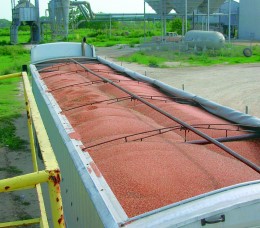The nation’s corn, soybean and sorghum harvest continues to push ahead of the five-year average. On Monday, the U.S. Department of Agriculture reported the nation’s corn harvest was 75 percent complete. That’s eight points ahead of average. Soybean harvest has reached 87 percent complete. That’s seven points ahead of average. Sorghum was 71 percent harvested. That’s ten points ahead of average. Peanuts were 58 percent harvested. That’s nine points behind average. Cotton harvest was 42 percent complete. That’s near the five-year average.

This was the first week USDA has rated the condition of the nation's winter wheat crop. This year’s crop doesn’t look as good as a year ago. Nationally, the winter wheat crop was rated 47 percent in good to excellent condition, 39 percent fair and 14 percent poor to very poor. That’s well behind last year’s crop condition of 59 percent good to excellent, 34 percent fair and seven percent poor to very poor. The nation’s winter wheat crop was 83 percent planted. That’s two points behind average. Sixty-two percent of the crop has emerged. That’s in line with the five-year average. Click here for the full National Crop Progress report.
Despite heavy rain during the latter part of the week in the Panhandle, Southeast, and South Central areas, dry weather was prevalent throughout Oklahoma for much of the week. In the weekly crop progress report from USDA, the state's winter wheat planting was 85 percent complete and 62 percent of the crop has emerged. USDA rated 31 percent of the crop in good to excellent condition, 47 in fair and 22 in poor to very poor condition. Canola emerged reached 65 percent.
Oklahoma's corn harvest reached 88 percent complete. That's ten points ahead of last year, but four points behind normal. Sorghum harvest was 66 percent complete. That's five points ahead of last year and eight points ahead of normal. Peanut harvest reached 51 percent complete. That’s nine points ahead of last year and up two points from normal. Soybeans were 35 percent harvested. That’s up four points from last year and down three points from normal. Cotton harvest was 20 percent complete. That's up six points from last year and down four points from normal. Click here for the full Oklahoma report.
Heavy rainfall was reported across most of Texas last week. Areas of the Blacklands received upwards six inches with isolated areas recording upwards of 20 inches of rainfall. Winter wheat seeding experienced delays. USDA reported 67 percent of the wheat crop has been planted and 44 percent has emerged. Both remain behind last year and average. Corn harvest only gained two points this past week with 77 percent of the crop harvested. That’s equal with last year at this time, but 13 points behind the five year average. Soybeans were 80 percent harvested. That’s near the five year average of 82. Sorghum harvest was 80 percent complete. That’s four points ahead of last year and average. Peanuts were 42 percent harvested. That’s five points ahead of last year, but 15 points behind average. Cotton harvest was 37 percent complete. That’s eight points ahead of last year and three points ahead of average.
Click here to see more...